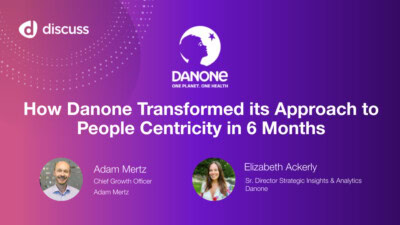How the Insights Industry Earned Its Seat at the Table: Getting to the Nitty GRIT-ty with Greenbook’s Leonard Murphy

Discuss Co-Founder and Chief Strategy Officer Jim Longo virtually sat down to interview Leonard (Lenny) Murphy, Executive Editor & Producer of the Greenbook Research Industry Trends (GRIT) Report, about how the Insights & Analytics industry has evolved.
The GRIT Report is the leading survey of the insights industry, analyzing trends, providing benchmarks, and serving as a strategic planning resource for researchers. Over 59,000 insights professionals and executives read each new edition of the report.
Topics covered: the great “Oh sh** moment” of 2020, sample supply shortages, messy Venn diagrams, and why Lenny doesn’t call it “market research” anymore.

Jim: In the Insights Practice Report, I liked that you explored how buyers choose a supplier. Many people think it comes down to price, but if you’ve been in the MRX space for long, it’s never just about price. That leads me to wonder, how do you think the buyers look at innovation today, compared to when you started this report?
Lenny: We used to think about innovation from a form factor standpoint, the ‘how to report over’ — paper and pencil to telephone. What hadn’t changed was the paradigm, which was centered on the survey and the focus group. While it was important to focus on form factors, particularly the migration of digital formats, I think that we missed opportunities in the past. We first saw the big boom around customer relationship management (CRM), which evolved into customer experience (CX), then research kind of lost CX. Now, there are some big players that are focused on CRM, and it’s part of research, but research doesn’t own it anymore.
Jim: What shifted and led businesses to think more holistically about the impact of Market Research and Insights on their bottom line?
Lenny: A few things converged. From a supplier standpoint, industry leaders looked and said, “We don’t want to miss the boat again. We need to start rethinking.” That’s why I don’t call the industry ‘Market Research’ anymore. I call it ‘Insights and Analytics’ because it’s a more accurate description of what we do, it’s a bigger tent. That’s been reflective of how both buyers and suppliers are thinking more holistically and looking for different data sources that are fit for purpose. It’s about data, and alignment of data to address a business issue.
Jim: Let’s talk about how COVID-19 further accelerated change, how did it affect the evolution of the industry?
Lenny: In 2020, some things certainly were disrupted, but more than anything, it accelerated trends that had already been there. In Q2 2020 we had a real ‘Oh sh** moment.’ We needed to figure this all out really quickly and cheaply. So, speed, cost and scale became paramount to research — it wasn’t about strategy, it was about tactics. Brands needed to get a handle on things really quickly, so full service took a backseat and tech rose to the occasion.
Jim: Do you think that this transition towards tech innovation is a novelty, and that the old ways of doing things may kick up again over time?
Lenny: Tech proved that we don’t have to do things the old way. The ability to leverage lots of different data sources seemed to feel like the new paradigm. The good news is, we did see the shift and the need for full service came back to the fore – that’s been great for the full service community, and it’s not going to go away.
Jim: Do you think that there’s now a tension between tech and full service market research that are at odds with one another?
Lenny: I think the Insights & Analytics industry is in a really healthy place now, where the dichotomy of the tech industry vs. service is not a dichotomy anymore. It’s more like a really messy Venn diagram. I think of it as tech-led vs service-driven. Those are the two dominant business models and they’re really synergistic. And I think they’re supporting new innovation within the supplier community. In addition, brands continue to ask for more innovation to synthesize information, and to gain better connection to consumers.
Jim: We’re at a critical moment with sample supply. It used to be that one person was on 7 different panels; now it’s up to 14 panels. In terms of purity of samples and getting fresh respondents, we need to again discuss something that has been a hot topic for the past 30-40 years: respondents do work for us. I’m just hoping that innovation allows us to be less dependent on engagement with the customer so that we can observe them in other ways.
Lenny: We’ll get there, but there are external forces that have to be dealt with, one is data privacy, which leads directly to value proposition and a fair value exchange. These people are providing a service and we need to treat them fairly in terms of how we engage them, whether that is an active conversation or a passive observation. That’s where innovation has to come in and create a fair value exchange for these people – there’s a huge opportunity there.
Jim: Can you speak more about the importance of connecting with and valuing respondents?
Lenny: It doesn’t matter how big you are, if you don’t have quality engagement with consumers, you have no business. There’s nothing we can sell without strong connections to the consumer; it’s a bedrock issue, and it’s scary that more people aren’t paying attention to it.
Jim: My big bet 10 years ago was that people would eventually start doing their own qualitative research, just like they started doing surveys with SurveyMonkey (now Momentive) and Qualtrics, for example. And now we’re here. Brands adopted this DIY qualitative approach first, looking to get closer to the consumer. And by allowing Consumer & Market Insights teams to pick up on some of the data collection tasks, they can focus on strategy and analyzing the data. And that’s where the value of tech really comes in.
Lenny: So let’s talk about the GRIT data. We asked what business issues the Insights team is engaged in, owns or influences. We also asked who their clients were, what are the other internal teams they engage with. That’s been interesting to see, this broadening of the tent. But there are still firewalls between some segments of the organization. When we looked at where investments are being allotted, in the insights space, tech, and looked at the hiring trends, we found that what you’re saying is right: there’s a tech-driven democratization happening, with an emphasis on leveraging information to serve the business vs. the tactical focus of ‘here’s how our ad test performed’ — tech is doing that.
However, in the typical day in the life of a researcher, we thought we’d see more people saying they’re spending their time doing more strategic, consultative stuff. That’s not what we’ve seen.
Jim: What has technology driven then?
Lenny: It’s addressing the bandwidth and volume issue – Insights is managing more projects. In terms of how a corporate researcher is spending their day, it depends on their role of course. For folks that are really in hands-on roles, a huge chunk of their day is still spent running projects rather than being at that ‘seat at the table’ in a consultative role. It is interesting that we haven’t gotten to that Nirvana point yet from the brand side where tech has freed them to just focus on the big picture stuff. No — tech has given them just as much to manage if not more to manage.
“There’s a tech-driven democratization happening, with an emphasis on leveraging information to serve the business vs. the tactical focus of ‘here’s how our ad test performed’ — tech is doing that.”
Jim: That makes a lot of sense, it allows you to have a wider view and to have more projects; but at the same time, you’re handling more projects. That’s where I see more leveraging of tech. Even though there was that initial fear of AI taking over things and putting more people out of a job, people don’t think that way anymore, they realize that someone needs to interpret that data and make a decision based on it.
Lenny: Right. We may see chatbots for survey questions, sure, but leveraging technology is more about fit for purpose. The way I see it, the more tactical and standardized the questions are, the more automation and AI will take those aspects over. And the more strategic we become, the more we realize that humans are needed to understand the data and communicate it effectively.
I think the Insights industry is in a fantastic place. We did earn our seat at the table in 2020. I can’t think of another time in history of the Insights industry where there was such an event that affected so many all at the same time; where there was so much uncertainty that we needed answers. That’s not going to go away anytime soon, and now it’s about getting better and more efficient, and being ready for the next “Oh sh**” moment.
Jim: Where do you see GRIT going in the future?
Lenny: I think the goal for GRIT has always been to be like all research – actionable. We cover a lot of topics, we’re evolving, we’re dealing with our own form factor issues now. I love to read a 200-page report, but we need to evolve around usability. Because if it’s not usable, it’s not actionable, because nobody’s going to understand what’s in there. I would love to see GRIT become data currency within the insights space. To a large extent it’s there already, but I would love to see it expand in terms of the audience that finds it useful. I just want to see it continue to deliver on the needs of the industry.
Vote for your favorite innovative insights companies later this month as nominations for the “2022 GRIT Top 50” opens as part of the 2022 Business & Innovation GRIT Survey later this month.
Ready to unlock human-centric market insights?
Related Articles

5 Trends Shaping the Future of Qualitative Insights
By Jim Longo, Co-Founder & Chief Strategy Officer at Discuss Each year, the Greenbook Research Industry Trends (GRIT) Business &…
By Jim Longo, Co-Founder & Chief Strategy Officer at Discuss Each year, the Greenbook Research Industry Trends (GRIT) Business &…

Navigating Tomorrow: A Glimpse into the Future of Market Research in 2024
Author: Jim Longo, Co-founder & Chief Strategy Officer As a veteran with over 30 years in the market research industry,…
Author: Jim Longo, Co-founder & Chief Strategy Officer As a veteran with over 30 years in the market research industry,…

Qualitative Research: Understanding the Goal and Benefits for Effective Analysis
As market trends evolve at lightning speed in the age of digital transformation, having an intimate understanding of consumer desires…
As market trends evolve at lightning speed in the age of digital transformation, having an intimate understanding of consumer desires…



